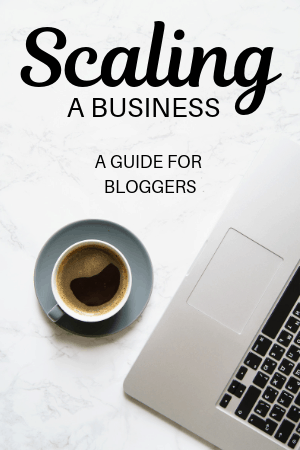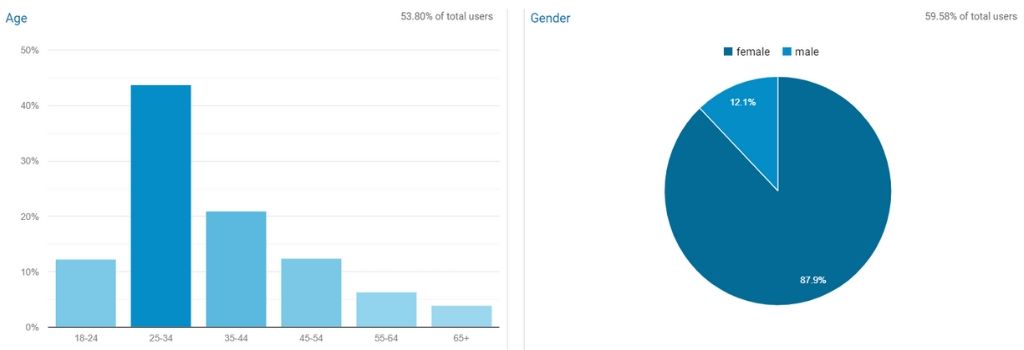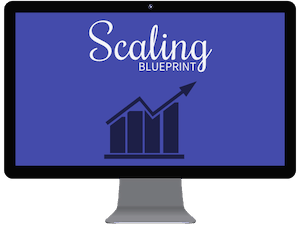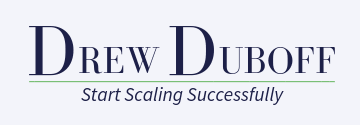One of the most challenging things to do in blogging is scaling your business.
Can I get an amen?
Without a doubt, there are not enough resources to explain all of the components.
So, I wanted to create a guide that did just that.
Advice for brick and mortar businesses doesn’t necessarily cut it for bloggers since their business models are starkly different.
For the past year, I’ve been working behind the scenes with some amazing 6-figure and 7-figure bloggers, helping them build systems, scale their businesses, and reach new revenue heights.
Today, that’s what I’d like to accomplish with this article.
I’d like to give you an unfiltered perspective of what it REALLY takes to scale an online business, and more specifically, a blog. This is the hard work, sheer grit, and true determination it takes to turn your blog into a money-making machine.
Let’s get started!

What is Scaling?
Scaling your business operations is an art form and a skill very few bloggers get right the first time.
When I use the word scaling, I’m referring to adding revenue exponentially compared to expenses.
For example, a blogger may sell a digital product priced at $297 through Facebook ads where each purchase has a cost of $20, for example. You may get a lower cost per lead, but after your email funnel, that’s what the final cost looks like.
Well, making $297 and it only costing you $20 is scaling. If you had hired someone to go on a discovery call with them before purchasing, your cost per purchase goes up much more (especially for people you can’t close).
There, your revenue increases, but so do the expenses.
That’s not scaling.
That’s actually growth and we’ll discuss that next.
The Difference Between Growth and Scaling
As I just mentioned, scaling is adding revenue at a much higher rate than expenses.
Growth is when you’re adding revenue on at the same time that you’re adding expenses.
So, in the example above, hiring that salesperson to close the sale puts you in a position of growth. Now, if you raise the price to retain a more desirable ratio, then you’re prime for scaling.
If you just launched an eBook and don’t have enough time to deal with customer service, you may hire someone.
Great decision!
Well, now that you’re doing that you’re adding expenses because of your revenue.
That makes your bottom line rather slim.
The good news is that once you successfully grow, you can position yourself to scale. But, you’ll never scale successfully before you grow.
For some, the growth period will take significantly longer, thus delaying scaling.
That’s okay!
Those that scale too quickly tend to not be able to deal with the onset of responsibilities.
5 Steps to Scaling a Blogging Business
As I mentioned before, a lot of bloggers do not nail this the first time.
There are usually elements that are overlooked until they have to be dealt with.
Instead, you’ll want to go in with a plan.
By strategically thinking about your endgame and taking the steps to make that a reality, you’ll have foreseen the majority of the issues before they happen.
Here are the 5 steps to scaling a business if you’re a blogger:
- Clarify your niche with precision
- Productize your business (add cash flow)
- Document, standardize, streamline, and simplify your business processes
- Hire and train a team of freelancers that believe in you
- Promote your blog strategically
Let’s explore these topics in a little more depth!
1. Clarify Your Niche With Precision
Every professional blogger out there has probably said to you at one time or another…
You need to niche down to make money.
I do believe that to a certain extent.
But, there are multiple ways that you can niche down:
- Serve a specific audience with different kinds of content
- Serve a specific topic to a specific or general audience
Both of these have produced successful bloggers.
I will say that niching down is a struggle of mine, if I’m being 100% honest.
I don’t know if I should target bloggers or freelancers or both and I don’t know if my topics are of interest to those people.
But, I’m not scaling my business yet, so I have some time to figure that.
With my clients, they have clearly defined niches and that is what allows them to productize (the next step in scaling).
The term target avatar has been tossed around in the blogosphere and in the marketing world for some time now and it’s an incredibly important term. You need to know who your audience is.
I like looking at the demographics report in Google Analytics for a brief overview of who I’m already serving.

Ideally, you should be creating content for that audience and solving their problems.
But, you can also be more specific than that and clarify who your audience is.
I know entrepreneurs who write pages upon pages about their avatar. I don’t know that this is entirely necessary, but it allows them to effectively communicate with their audience.
Communicating and understanding your audience is crucial for the next scaling stage.
2. Productize Your Business (Add Cash Flow)
There are multiple ways you can productize your business:
- eCourses
- eBooks (and other digital downloads like printables, workbooks, etc.)
- Services (specifically, coaching)
When it comes to productizing, the first two options are the best.
Coaching can be difficult to scale because it’s always a trade-off with your time.
However, coaching is a great way to begin to understand your audience’s pain points.
I’ve been doing that for some time now and made over $1k in the first 3 months with a list size of under 100 (yes, you can start productizing with a small email list).
Here’s a model that works if you want to start out with coaching:
- One-on-one coaching
- Group coaching
- eCourse
If you follow that sequence, you’ll be golden.
The whole point behind productizing is that it gives you cold hard cash (aka cash flow).
Now, you need to manage this properly.
I recommend using the Profit First system for cash flow management.
Having sufficient cash flow enables you to hire freelancers and up your ante on software that can help you automate and optimize your processes.
And, that brings us to the next section.
3. Document, Standardize, Streamline, and Simplify Your Business Processes
This is one of my favorite stages.
But, you have to understand going in that a lot of this is the most thankless work you will come across in your online business.
So, with business processes, you want to do this to your operations:
- Document
- Standardize
- Streamline
- Simplify
If you’re not already using a project management tool, I highly recommend it.
I’ve used Asana and Trello with clients before, but I’m really loving Clickup right now.
I’ll have to do a tutorial on it at some point, but I love its tiered hierarchy organization and I think that structure works well for bloggers, freelancers, and solopreneurs of all kinds.
In addition to project management software, you should have a resource hub where all your processes have been outlined for others to follow.
If you use GSuite for your domain-specific emails, you might find the prospect of building out a Google Site intriguing and giving your freelancers access to it through their company emails.
You can also document your processes in Google Drive or Dropbox, but I prefer to use those for asset management.
Here are the crucial components to systemizing your business:
- Invest in the right software that can help you stay organized
- Write down anything you do more than 3x in your business as this is a repeatable task and can be outsourced
- Build out a hub for all your processes to live and be accessed by your entire team
And, speaking of your team, that brings us to the next section.
4. Hire and Train a Team of Freelancers That Believe in You
If you haven’t already begun outsourcing in your business, now is the time!
Since you’ve already documented your processes, it should be easy to outsource them (provided your tasks have been simplified).
There are two different kinds of freelancers you’ll need in your business:
- Knowledge workers
- Routine workers
Knowledge workers are people that you hire because of their specific knowledge on a topic.
This could be hiring a Clickfunnels specialist to help you optimize your funnels. Or, it could be a freelance writer that’s certified in the topic you discuss on your blog.
Routine workers are people that you hire to perform repeatable tasks.
In the virtual assistant world, we call this general VA or admin work.
This could be things like spreadsheet management, calendar management, inbox management, etc.
In my opinion, ANYTHING can be a repeatable task if you’ve streamlined it properly.
The best people to hire when building your team are people from your audience.
They are already invested in your blog and they want to see you succeed.
My Pinterest manager is incredibly supportive and she believes in me like no one else. Having that kind of person on your team is simply amazing.
5. Promote Your Blog Strategically
Once you’ve got a crystal clear niche with a product that solves your audience problems and documented systems that your team can follow, you’re ready to promote your blog.
There are many different ways to promote your blog to gain traction in front of your target market (if you don’t know who that is, revisit stage #1).
The key here is to do it strategically.
Wasting time here leads to wasting money.
Remember, you’re paying for team members now, so your expenses are increasing. You need to find a way to position yourself and get sales without expending too much energy and time getting there.
If you are afraid of heavily promoting yourself, start with just one promotional strategy and master it.
But, you do need to understand that the only way to get more revenue is to get your product and mission in front of more people.
Period.
You’ll let your optimized systems do the heavy lifting once you get more leads in your funnel.
7 Promotional Strategies for Scaling a Business
There’s no one best promotional strategy for scaling a business.
Honestly.
It all depends on how your online business works.
Without further ado, here are 7 promotional strategies for you to experiment with:
- Paid advertising
- Joint venture campaigns
- Search engine marketing
- Influencer marketing
- Media promotion
- Book publishing
- Speaking opportunities
Let’s explore these topics a little more!
1. Paid Advertising
Calling all ads and optimization specialists! This is your time to shine.
Ads are available on a lot of social media and search engine platforms.
Here are a few:
- Google AdWords
- Facebook ads
- Instagram ads
- Pinterest promoted pins
- Twitter ads
- LinkedIn ads
- Bing ads
The idea behind paid advertising is that it AMPLIFIES your efforts elsewhere.
For example, you have an email funnel for your eCourse that converts at a fair 1%.
Awesome and congrats!
You know that for every 100 people that come in at the top of your funnel, 1 person will purchase.
You’re taking an existing funnel and sending more people to it. It’s bound to work. It’s proven to work.
Ads are also when you get to have a little fun with split testing.
It’s always a good idea when running ads to split test your images, copy, landing pages, etc. If it can change, it should be split tested at some point.
Split testing can help you discover a better conversion rate by making the smallest of changes.
If you can get your cost per lead at a low rate, then paid advertising will work for scaling a business.
You can also use webinars as a video sales letter, which tend to convert well.
2. Joint Venture Campaigns
You may have heard of this by its other name: JV launches.
The idea behind this is that you partner with businesses that have an audience interested in topics that your product covers.
Let me break this down a little more with an example before I lose you.
You’re a blogger that has created the most amazing Pinterest templates and you’ve created them in Canva, PicMonkey, Stencil, and Photoshop (perfect for bloggers of all different design backgrounds).
You find someone with a Pinterest course and decide to do a joint venture webinar together with a follow-up flash sale via email. You think that for someone looking to amp up their Pinterest efforts, a bunch of pre-made ready to go templates would be great.
So, the partner gets a commission for all sales and you get yourself exposed to a new audience.
You can repeat this process as many times as you’d like.
If you haven’t yet seen one of these email sequences yet by email, sign up to some of the original gangsters of email marketing with massively sized lists. They tend to do JV launches at least once a quarter.
This promotional method will take some more time on the creative side to produce, but the connections made can be long-lasting and grow your email list.
3. Search Engine Marketing
Hello, SEO!
Hopefully, you’ve come across search engine marketing (SEM) or search engine optimization (SEO) before.
And, no, I don’t mean Yoast SEO.
Optimizing to green in Yoast does not mean that your articles will rank. Yoast is a guide, not a bible.
If you’ve niched down properly and taken the time to build out your expertise, authority, and trust (E-A-T), then you should strive for Google traffic.
Google traffic is one of the BEST ways to scale a business because it requires very little effort in maintenance once you begin to rank. If you can rank for some highly searched keywords relevant to your product, then you can use content marketing to sell it.
Talk about passive revenue!
Since March, when I launched my Scaling Success Stories, my organic search traffic has quintupled

It shows my increase from February 2019 when I had 50 visitors each month (hadn’t created content in a while) to July 2019 where I have about 300 visitors each month and 25 articles (an increase of 22 articles over that span).
If you really want to get better at SEO, there are a couple of eCourses/eBooks I recommend:
- Stupid Simple SEO by Mike Pearson
- Easy Backlinks for SEO by Debbie Gartner
- Easy On-Page SEO for Beginners by Debbie Gartner
I’ve personally taken all of these and they are contributing heavily to my increase in almighty Google traffic.
4. Influencer Marketing
Influencer marketing is the process by which you hire influencers to promote your product for you.
To bloggers, this is known as sponsored post campaigns.
Basically, you, the blogger, functioning as an influencer, work with companies to market their products.
There are a few main distribution channels:
- Social media
- Blog posts
- Email newsletters
- Paid ads
Of course, there are more creative marketing methods, but those are the basics.
In this case, if you wanted to use influencer marketing to scale your business, you’d do a role reversal. You’d be the company, not the influencer.
This is similar to joint venture campaigns, but the compensatory package is fixed and not based on sales.
Depending on your budget and if you can afford to promote your product in this way, influencer marketing might be for you.
5. Media Promotion
Don’t you love it when the media covers your story or quotes you in a piece?
It’s amazing!
Because of media promotion, I’m happy to report that I’ve been featured as a freelancing/business expert in:
- Business.com
- Business Insider
- Yahoo Finance
- MSN
- The Penny Hoarder
- And more!
The majority of that has come through a service called Help a Reporter Out (HARO) where journalists send out queries on topics they’re writing about and you can answer them and get quoted.
It’s been a great way to build backlinks and increase my domain authority (DA) to 23 in roughly one year.
But, you can also pitch the major media publishers directly to guest post.
My friend Susie Moore was able to gain over 29,000 email subscribers in 9 months just from guest posting.
However you get published, make sure to try and promote a link to your product so that if people like what they see, they can purchase something from you.
6. Book Publishing
Do you remember that old-fashioned thing called a book?
Yeah, it’s still around.
It does a pretty effective job of selling your programs.
Why?
Publishing a book gives you INSTANT credibility. If you’re a published author, then people really consider you an expert and will buy into your training.
Here are a few entrepreneurs that have used book publishing to scale their business:
- Michael Hyatt
- Ruth Soukup
- Jeff Goins
- Tim Ferriss
If you have an interesting story to tell, consider getting an agent to pitch publishers.
I’ve got a book idea I want to see published, but I’m not telling you so you don’t steal it. Love ya <3
Book publishing, guest posting, and speaking really go hand in hand.
7. Speaking Opportunities
If you’ve established yourself as an expert, consider speaking opportunities to further your reach.
This can be anything from speaking at TEDx talks to going on a speaking tour for your newly published book.
Speaking across the country and world isn’t for everyone, but it will give you an opportunity to travel.
If you want to get started speaking, make sure you have a few topics you can speak at length about and prepare speeches/presentations on them.
You’ll want to try these out on some groups of people in your target market first.
After that, use an agent to book you some gigs and speak your heart out.
FAQs on Scaling a Business
Since you probably still have questions, I took the liberty of answering some of the ones you may have been thinking of.
If you have any more, drop them in the comments below and I’ll be happy to answer them.
1. What Does it Mean to Scale a Business?
I discussed this a little earlier in the article, but scaling a business is when you add on additional revenue without matching expenses.
It’s the idea of refining your product and preparing it to be positioned in front of a lot of potential customers.
Scaling a business is usually concerned to be the final frontier.
At this point, you’ve:
- Brainstormed about starting a business
- Started the business
- Grew the business
All that’s left is to scale it.
This is the part that you’ll probably spend the rest of your entrepreneurial life on.
If you’re ambitious, you always want to know how to scale your business beyond its current heights.
2. What Does Scalability Mean in Business?
Scalability in business refers to how well your business is able to be scaled.
In other words, if you tried to scale right now at this very moment, would it go well? Would you succeed and flourish?
If you answered yes to those questions, then you have a lot of scalability. If you answered no to those questions, then you are not positioned properly to scale.
When assessing scalability, think of the five stages that I mentioned earlier in the article as criteria:
- Niche
- Products
- Processes
- Team
- Promotion
Take out a piece of paper and create a matrix. Score your comfort and proficiency (in all honesty) from 1-5 in each of these categories. Add up your totals and see what areas you need to work on.
Call that your scalability score.
Make changes and revisit that chart. Did you score better?
Aim to have at least a 4 in each category before you prepare to scale.
3. What is a Scaling Strategy?
A scaling strategy is what you’re going to do to scale.
It sounds kind of basic, but that’s what it is.
For example, your scaling strategy might look like:
- Create an eCourse
- Systemize with Clickup and document tasks
- Hire freelancers from your audience
- Guest post on major media outlets
It combines the steps for scaling a business and the promotional strategies to get your brand visible.
If you prefer to have a little more structure than just a checklist, create a business plan for your business for the next few years. Then, try and make that a reality.
4. How do you Scale a Business?
The short answer: with patience.
The long answer: spend countless hours optimizing your systems and doing thankless tasks in your business to make your product and business the absolute best thing for customers in your market and then do everything you strategically can to reach them.
This guide provides A LOT of information for someone looking to scale, but I understand that scaling isn’t a one size fits all approach.
If you think you need additional one-on-one support, consider hiring me for coaching.
Conclusion
I hope this post explained to you the key tenets of scaling a business.
We first talked about what scaling is and then the difference between growth and scaling.
After that, we discussed these 5 stages of scaling a blogging business:
- Clarify your niche with precision
- Productize your business (add cash flow)
- Document, standardize, streamline, and simplify your business processes
- Hire and train a team of freelancers that believe in you
- Promote your blog strategically
Then, we expanded upon strategies to promote your blog and discussed these:
- Paid advertising
- Joint venture campaigns
- Search engine marketing
- Influencer marketing
- Media promotion
- Book publishing
- Speaking opportunities
Then, we wrapped up with a few frequently asked questions on the topic.
I hope you feel a lot more prepared to scale your business now!
If I left anything out or you’re stuck on one of the stages, please let me know in the comments below.
I want to support you in any way I can.
Cheers to future success!





This article really clarified some terms that I’ve been overlooking, mainly because I didn’t understand them…until now. I learned so much from reading this article and now I feel like I have a path that I can actually follow in order to scale my business. Thank you so much for such a great article!
Awesome, Kari! This is SO great to hear. Please keep me posted on your progress <3